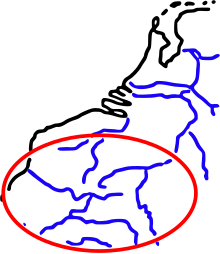Seine-Oise-Marne culture
The Seine-Oise-Marne culture (SOM culture) is a culture named after the three rivers Seine , Oise and Marne of the end Neolithic and the Copper Age (about 2900–1700 BC) in northern France and Belgium ( megalithic sites near Wéris ) . It shares with the groups Kerugou (Atlantic coast), Vlaardingen (Netherlands), Wartberg, Horgener Kultur , Goldberg III group , and Chamer group a very coarse, rarely decorated, barrel-shaped pottery. Other contemporary groups are the Remedello culture (Northern Italy), the Lüscherzer group , the Eyersheimer and the bell- beaker culture . It was named by Bosch-Gimpera in 1926 , and Gérard Bailloud presented the first overall representation in 1974 .
Characteristic are graves in natural and artificial caves in the valley of the Marne, in Champagne and megalithic gallery graves like the gallery grave of Guiry-en-Vexin as well as the installation of menhirs and rows of stones . In contrast, only a few settlements are known.
Sepulchral culture
In the upper Marne region , the chalk cliffs enable rock necropolises to be built . About 100 rock chambers were cut into slopes. Short corridors lead through an oval anteroom into one or two almost square chambers with up to 1.70 m high, flat ceilings. They have sides up to about four meters ( Mournouards II ). On the smooth, light walls there are occasionally depictions that seem to come from the statue menhirs of the south. The shape of the stele, rounded at the top, was carved into the rock. The breasts, the owl face, the necklace, multi-row or simple are shown
with a yellow-brown pearl in the middle. In Courjeonnet of the input is an in the main chamber side geschäftete Doppelaxt shown. Numerous skeletons lay here.
Graves with worn thresholds must have been used for a long time; the skeletons often filled them to the exit.
The poor grave goods from the Marnegrotten are juxtaposed with the equipment industry and valuable jewelry from the necropolis in the south of France . There are stone axes and daggers , cross-edged arrowheads of the Mesolithic tradition, pearls made from mussel shells, stone, horn and bone and raw, flowerpot-shaped clay vessels . The simple and coarse ceramic is related to the Horgen culture. The representations of the goddess and the execution of the burial chambers show a powerful culture.
Occasionally reduced to the breasts and the necklace, the deity also appears on the walls of the Allées couvertes in the Seine area . These long structures are galleries sunk into the ground , accessible through perforated door stones and divided by plates.
Trepanation
The trepanation was in Paris Basin widespread. Treated skulls lay in almost all the Allées couvertes , and many slices of bone were found among the additions. Even more mysterious than drilling the skull are T-shaped signs that were carved into a number of female skulls during their lifetime. They resemble the double ax depicted in a rock grave on the Marne.
See also
literature
- Emil Vogt : Horgen culture, Seine-Oise-Marne culture and Nordic stone boxes. In: Anzeiger für Swiss Archeology. Vol. 40, No. 1, 1938, ZDB -ID 280173-5 , pp. 1-14, ( online ).
- Sibylle von Reden: The Megalithic Cultures. Evidence of a lost original religion. Major monuments in England, France, Ireland, Corsica, Malta, Northern Europe, Sardinia, Spain. 3rd, revised and changed new edition. DuMont, Cologne 1982, ISBN 3-7701-1055-2 .
- Johannes Müller : The Neolithic Age. (6000-2000 BC). In: Siegmar von Schnurbein (Hrsg.): Atlas of the prehistory. Europe from the first humans to the birth of Christ. Theiß, Stuttgart 2009, ISBN 978-3-8062-2105-3 , pp. 60-107.

